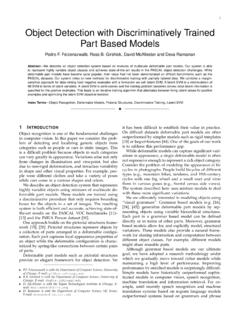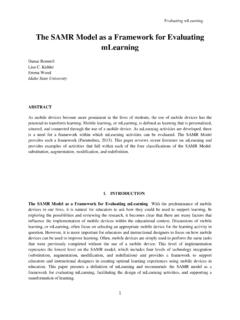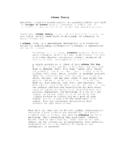Transcription of arXiv:1512.02325v5 [cs.CV] 29 Dec 2016
1 SSD: Single Shot MultiBox DetectorWei Liu1, Dragomir Anguelov2, Dumitru Erhan3, Christian Szegedy3,Scott Reed4, Cheng-Yang Fu1, Alexander C. Berg11 UNC Chapel Hill2 Zoox of Michigan, present a method for detecting objects in images using a singledeep neural network. Our approach, named SSD, discretizes the output space ofbounding boxes into a set of default boxes over different aspect ratios and scalesper feature map location. At prediction time, the network generates scores for thepresence of each object category in each default box and produces adjustments tothe box to better match the object shape. Additionally, the network combines pre-dictions from multiple feature maps with different resolutions to naturally handleobjects of various sizes.
2 SSD is simple relative to methods that require objectproposals because it completely eliminates proposal generation and subsequentpixel or feature resampling stages and encapsulates all computation in a singlenetwork. This makes SSD easy to train and straightforward to integrate into sys-tems that require a detection component. Experimental results on the PASCALVOC, COCO, and ILSVRC datasets confirm that SSD has competitive accuracyto methods that utilize an additional object proposal step and is much faster, whileproviding a unified framework for both training and inference. For300 300in-put, SSD achieves mAP1on VOC2007testat 59 FPS on a Nvidia TitanX and for512 512input, SSD achieves mAP, outperforming a compa-rable state-of-the-art Faster R-CNN model .
3 Compared to other single stage meth-ods, SSD has much better accuracy even with a smaller input image size. Code isavailable at: :Real-time object Detection; Convolutional Neural Network1 IntroductionCurrent state-of-the-art object detection systems are variants of the following approach:hypothesize bounding boxes, resample pixels or features for each box, and apply a high-quality classifier. This pipeline has prevailed on detection benchmarks since the Selec-tive Search work [1] through the current leading results on PASCAL VOC, COCO, andILSVRC detection all based on Faster R-CNN[2] albeit with deeper features such as[3]. While accurate, these approaches have been too computationally intensive for em-bedded systems and, even with high-end hardware, too slow for real-time achieved even better results using an improved data augmentation scheme in follow-onexperiments: mAP for300 300input and mAP for512 512input on see Sec.
4 For [ ] 29 Dec 20162 Liuet detection speed for these approaches is measured in seconds per frame (SPF),and even the fastest high-accuracy detector, Faster R-CNN, operates at only 7 framesper second (FPS). There have been many attempts to build faster detectors by attackingeach stage of the detection pipeline (see related work in Sec. 4), but so far, significantlyincreased speed comes only at the cost of significantly decreased detection paper presents the first deep network based object detector that does not re-sample pixels or features for bounding box hypothesesandand is as accurate as ap-proaches that do. This results in a significant improvement in speed for high-accuracydetection (59 FPS with mAP on VOC2007test, vs.)
5 Faster R-CNN 7 FPS withmAP or YOLO 45 FPS with mAP ). The fundamental improvement inspeed comes from eliminating bounding box proposals and the subsequent pixel or fea-ture resampling stage. We are not the first to do this (cf [4,5]), but by adding a seriesof improvements, we manage to increase the accuracy significantly over previous at-tempts. Our improvements include using a small convolutional filter to predict objectcategories and offsets in bounding box locations, using separate predictors (filters) fordifferent aspect ratio detections, and applying these filters to multiple feature maps fromthe later stages of a network in order to perform detection at multiple scales. With thesemodifications especially using multiple layers for prediction at different scales wecan achieve high-accuracy using relatively low resolution input, further increasing de-tection speed.
6 While these contributions may seem small independently, we note thatthe resulting system improves accuracy on real-time detection for PASCAL VOC mAP for YOLO to mAP for our SSD. This is a larger relative improve-ment in detection accuracy than that from the recent, very high-profile work on residualnetworks [3]. Furthermore, significantly improving the speed of high-quality detectioncan broaden the range of settings where computer vision is summarize our contributions as follows: We introduce SSD, a single-shot detector for multiple categories that is faster thanthe previous state-of-the-art for single shot detectors (YOLO), and significantlymore accurate, in fact as accurate as slower techniques that perform explicit regionproposals and pooling (including Faster R-CNN).
7 The core of SSD is predicting category scores and box offsets for a fixed set ofdefault bounding boxes using small convolutional filters applied to feature maps. To achieve high detection accuracy we produce predictions of different scales fromfeature maps of different scales, and explicitly separate predictions by aspect ratio. These design features lead to simple end-to-end training and high accuracy, evenon low resolution input images, further improving the speed vs accuracy trade-off. Experiments include timing and accuracy analysis on models with varying inputsize evaluated on PASCAL VOC, COCO, and ILSVRC and are compared to arange of recent state-of-the-art The Single Shot Detector (SSD)This section describes our proposed SSD framework for detection (Sec.)
8 And theassociated training methodology (Sec. ). Afterwards, Sec. 3 presents dataset-specificmodel details and experimental : Single Shot MultiBox Detector3(a) Image with GT boxes(b) 8 8 feature map(c) 4 4 feature maploc: (cx, cy, w, h)conf: (c1, c2, , cp)Fig. 1:SSD framework.(a) SSD only needs an input image and ground truth boxes foreach object during training. In a convolutional fashion, we evaluate a small set ( 4)of default boxes of different aspect ratios at each location in several feature maps withdifferent scales ( 8and4 4in (b) and (c)). For each default box, we predictboth the shape offsets and the confidences for all object categories ((c1,c2, ,cp)).At training time, we first match these default boxes to the ground truth boxes.
9 Forexample, we have matched two default boxes with the cat and one with the dog, whichare treated as positives and the rest as negatives. The model loss is a weighted sumbetween localization loss ( Smooth L1 [6]) and confidence loss ( Softmax). ModelThe SSD approach is based on a feed-forward convolutional network that producesa fixed-size collection of bounding boxes and scores for the presence of object classinstances in those boxes, followed by a non-maximum suppression step to produce thefinal detections. The early network layers are based on a standard architecture used forhigh quality image classification (truncated before any classification layers), which wewill call the base network2.
10 We then add auxiliary structure to the network to producedetections with the following key features:Multi-scale feature maps for detectionWe add convolutional feature layers to the endof the truncated base network. These layers decrease in size progressively and allowpredictions of detections at multiple scales. The convolutional model for predictingdetections is different for each feature layer (cfOverfeat[4] and YOLO[5] that operateon a single scale feature map).Convolutional predictors for detectionEach added feature layer (or optionally an ex-isting feature layer from the base network) can produce a fixed set of detection predic-tions using a set of convolutional filters. These are indicated on top of the SSD networkarchitecture in Fig.
![arXiv:1301.3781v3 [cs.CL] 7 Sep 2013](/cache/preview/4/d/5/0/4/3/4/0/thumb-4d504340120163c0bdf3f4678d8d217f.jpg)
![arXiv:0706.3639v1 [cs.AI] 25 Jun 2007](/cache/preview/4/1/3/9/3/1/4/b/thumb-4139314b93ef86b7b4c2d05ebcc88e46.jpg)

![@google.com arXiv:1609.03499v2 [cs.SD] 19 Sep 2016](/cache/preview/c/3/4/9/4/6/9/b/thumb-c349469b499107d21e221f2ac908f8b2.jpg)






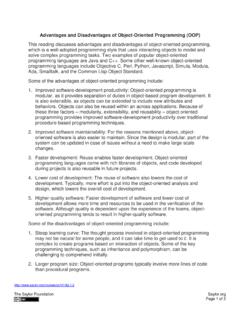
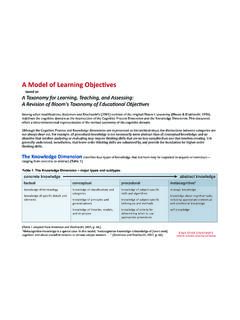
![Abstract arXiv:1506.02640v5 [cs.CV] 9 May 2016](/cache/preview/a/3/9/e/e/5/9/7/thumb-a39ee597b55a06b0e86e1cebc7152b1f.jpg)
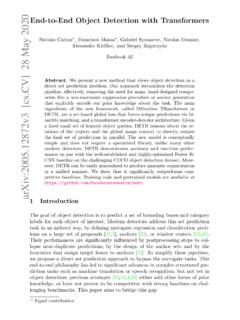
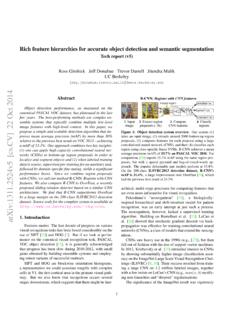

![Abstract arXiv:2103.02603v2 [cs.CV] 9 May 2021](/cache/preview/d/8/6/f/9/d/e/2/thumb-d86f9de271f3e441368a928ac5b32a7a.jpg)
